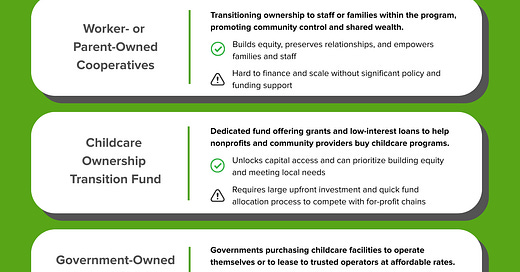Who a Child Care Program Sells to Matters
I have a new policy brief out with some ideas on public sector solutions to child care supply
Consider two different child care centers: one is in a rural town, the only center for miles around. The other sits in a middle-class suburb. Both of their owners are wanting to sell: perhaps they’ve simply reached retirement age, or perhaps a health situation in the family means they need to move across the country. Here’s the question: who are they going to sell to?
At the moment, there are two main answers: “nobody”1 and “an investor-backed for-profit chain.” I would argue that neither of those answers is fantastic for developing a strong child care system that provides parents with stable, abundant, high-quality options. I published a new policy brief last week via the Roosevelt Institute (and in collaboration with Capita), “‘Have You Ever Considered How You Might Transition Your Business to a New Owner?’: The Need for Publicly Supported Childcare Ownership Transition Models.” The title comes from an unsolicited letter that a private equity-owned company has been sending around to child care programs in the Midwest.
My brief argues that public sector actors should take a much more substantial role in helping nonprofits and trusted community providers acquire closing child care programs, as well as considering direct governmental acquisitions. Doing so would both strengthen overall supply — that is, it would be a good idea to do this even if there were no investor-backed chains — and would also act as a supply-side bulwark against unfettered expansion by the chains. (If you want to get a glimpse into a possible child care future of unfettered profiteering, take a look at this shocking investigation into one of Australia’s largest chains, which is owned by a private equity firm; fair warning that it is highly disturbing.)
Of course, the steps I’m outlining are no substitute for — and would work better with — permanent public funding that can power an inclusive, robust system. But this is one of those examples of a “good increment,” a step that can take us closer to the mountain and a piece of infrastructure we’ll need in a future system regardless.
I hope you’ll give the brief a read and share with local, state, and federal child care stakeholders and policymakers!
In which case they’ll just close up shop entirely or sell the building/land to someone who will convert it to a non-child care usage.




